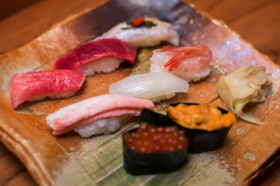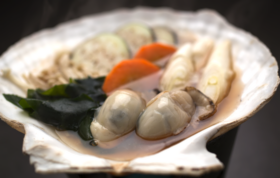 Food provided by Shinpuku
Food provided by Shinpuku

“We don’t need a fat wallet to eat fresh, quality meals here. All we have to do is to pick them from the farm, or the nearby sea,” says an organic farmer who moved to Oku-Noto from an urban area. “The most important thing is that we have enough time for enjoying good food and a laid-back lifestyle.” That is more than true.

You’ll never leave Oku-Noto without eating sushi.
Washoku, traditional Japanese cuisine, was recently designated by UNESCO as an Intangible Cultural Heritage. The world’s most well-known washoku should be sushi, which you may have already tried in Kanazawa. However sushi in Oku-Noto tastes different, as there is no time lag between its production and consumption. So get ready to enjoy more sushi when you travel across the peninsula. You will find many sushi restaurants in Wajima. In truth, you just can’t get a bad piece in this fishing town. But let’s try Shinpuku (伸福), where ex-fisherman chef make sushi with just-caught fish in a traditional Japanese setting.
Kaisou (seaweed) is another local specialty from the sea. Don’t miss the chance to try kaisou dishes such as kaisou shabu-shabu. You don’t like seaweed very much? Really, it’s just a vegetable.
Just a quick digression, there is an amazing group of women divers called ama in Wajima. Literally meaning “sea woman”, ama dive for abalone, seaweed and other shellfish. It’s lesser-known, but a fascinating part of Japanese culture.
Encountering dishes and ingredients unique to the region increases the pleasure of the journey.
Ishiru (ishiri) is a fish sauce which has been made in Noto Peninsula since ancient times. It is produced by the fermentation of squid entrails or sardines, and used to flavor soups, and boiled dishes. One of the most popular dishes is kaiyaki, served in the shell of a large scallop. Ishiru is put in the shell to boil other ingredients such as vegetables, seafood, seaweed and mushrooms. With the sweetness of the vegetables and ishiru’s unique flavor, you may be hooked after one bite. If you like it, you can buy bottled ishiru at souvenir shops. A few drops of ishiru goes well not only in Japanese dishes, but also in Chinese or Western cuisine.
Speaking of fermentation, sake is also made from fermented cooked rice. Noto Peninsula is known to be a leading sake-making region of Japan, as well as home to a skillful group of toji (brewers) called noto-toji. Wajima has several old sake breweries, and most local restaurants offer a good selection of local sake.
Bowl dishes showcasing the region’s produce and hospitality: Noto-don If you want to try a more diverse taste, or don’t like sushi, our suggestion is Noto-don (能登丼). Basically, Noto-don is donburi cuisine, a large bowl of rice with something on top of it. However, Noto-don is not a simple one. Developed as a new highlight of Oku-Noto tourism, a variety of Noto-don, from luxury delicacies to light meals, are served by local restaurants. In adherance to the guidelines, each dish is made with bountiful produce of Oku-Noto including rice, vegetable, fish, shellfish, beef and pork, and served in bowls made in the peninsula. Prices vary, depending on the ingredients. Pick up a Noto-don brochure at michinoeki or tourist information center, and choose the best option for you. After the meal, you can take the chopsticks (also made in Noto) home.
If you want to try a more diverse taste, or don’t like sushi, our suggestion is Noto-don (能登丼). Basically, Noto-don is donburi cuisine, a large bowl of rice with something on top of it. However, Noto-don is not a simple one. Developed as a new highlight of Oku-Noto tourism, a variety of Noto-don, from luxury delicacies to light meals, are served by local restaurants. In adherance to the guidelines, each dish is made with bountiful produce of Oku-Noto including rice, vegetable, fish, shellfish, beef and pork, and served in bowls made in the peninsula. Prices vary, depending on the ingredients. Pick up a Noto-don brochure at michinoeki or tourist information center, and choose the best option for you. After the meal, you can take the chopsticks (also made in Noto) home.



